One of the first vacations we took together was to Mammoth Cave National Park in Kentucky. Not so many years after that, we returned with kids. We’ve had an affinity for caves ever since, and when we first discussed this Western America road trip, Lori practically insisted on a stop at Carlsbad Caverns.
She’s been before; this was my first time. Ok, so I like caves, but—sorry all you geologists and spelunkers out there—after you’ve descended into a few caverns, they pretty much all look the same. The air is humid and cool, there are fancy stalactites and stalagmites, improbable-looking rock formations of all variety, and it’s really dark when they turn the lights out on you to demonstrate how dark “complete and total darkness” is (this kitschy but fun exercise is mandated by FUCTO, the Federated Union of Cave Tour Operators).
Where Carlsbad Caverns stands apart, in my book, is on the surface, with their use of lighting in the caves, and with everyone’s favorite cave-dwelling flying mammal: bats.
Driving through the forested and rolling hills of the Northern Kentucky countryside around Mammoth Cave, you can easily imagine the Earth’s crust being a Swiss cheese of caves. In fact it is quite common, we hear, for heretofore-undiscovered caverns to suddenly open up without warning beneath the tires of surprised motorists, swallowing them whole, so if you’re planning a drive through Kentucky, be careful.
The surface around Carlsbad, however, is arid desert and sharp, craggy rocks. The visitor center is perched near the edge of a cliff providing spectacular views of an expansive flat plain below: descending by elevator more than 70 stories from the visitor’s center into the caverns likely only puts you a bit below the floor of that plain, but we don’t want to steal the park service’s thunder. It is a long, lovely, and dramatic ride down their elevator. Our big surface moment experience came when we spotted a herd of majestic curly-horned mountain rams; we learned later they are an invasive species, but they were interesting nonetheless.
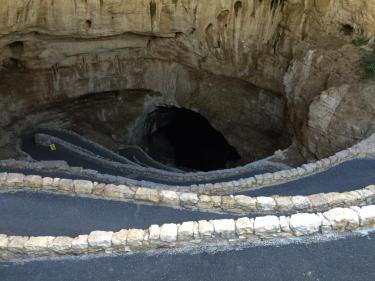
The Natural Entrance to Carlsbad Caverns
There were three main tours of Carlsbad the day we visited: two you conduct yourself, one that is ranger-led (additional fee required). We did all three. If you are ok to walk, don’t miss the Natural Entrance tour: most of the walking is down hill and you can take the lovely elevator back up. Along all three tours you’ll find placards describing the geologic processes that brought the caves about and the creatures who dwell there. You’ll also find Carlsbad’s other really nice touch: thoughtful (and dare I say artistic?) lighting.
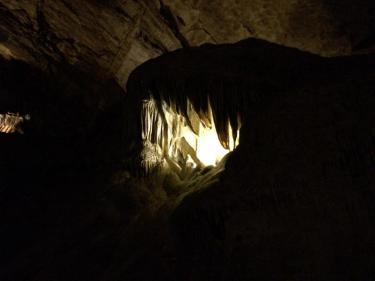
“Whales Mouth” rock formation
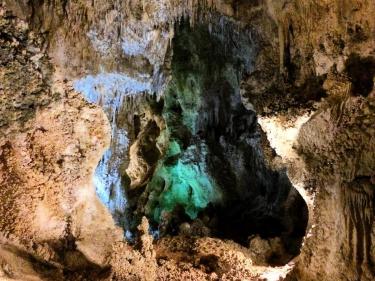
A Beautifully Lit Formation
Also at the bottom you’ll find restrooms and a small cafeteria, but unless you have a hankering for shoe leather costing more than its weight in silver we recommend you bring your own lunch. It’s also down here where you’ll meet your ranger if you elected to take a guided tour, and you should: we loved the King’s Palace tour and our ranger obviously knew his cave stuff.
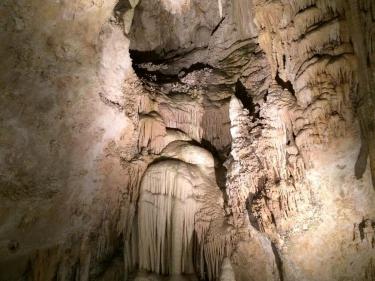
Another cool rock formation
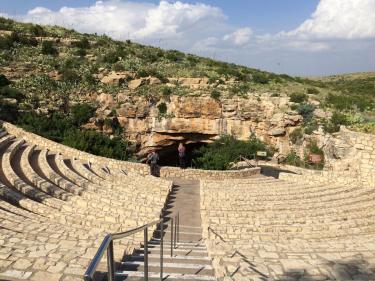
The Bat Amphitheater
As you wander through the caves, the topic of bats is sure to arise, and if you know anything about Carlsbad Caverns then one of the reasons you plan to come is likely to see the nightly bat flight. It’s one of the coolest things about Carlsbad Caverns and well worth your time. A little before twilight, visitors gather in an amphitheater overlooking the Natural Entrance, a ranger gives a talk, and then conducts Q&A until hundreds of thousands of bats decide its time to head out over those flat plains and find an In-N-Out Burger. Just kidding, bats prefer bugs to burgers-N-shakes. Our experience wasn’t the best (the lighting just wasn’t optimal the night of our visit so the little winged and furry fellas were hard to see), but the night you go it might be bat-perfect.
But don’t worry, we’ve seen plenty of bats this summer: more on this in an upcoming blog.
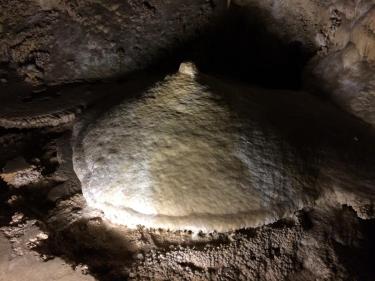
“Boob Rock”






